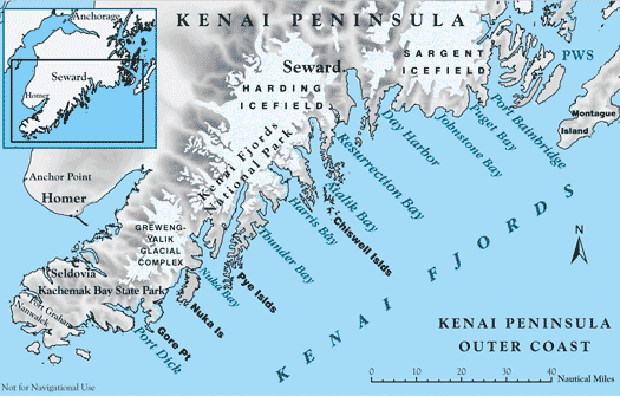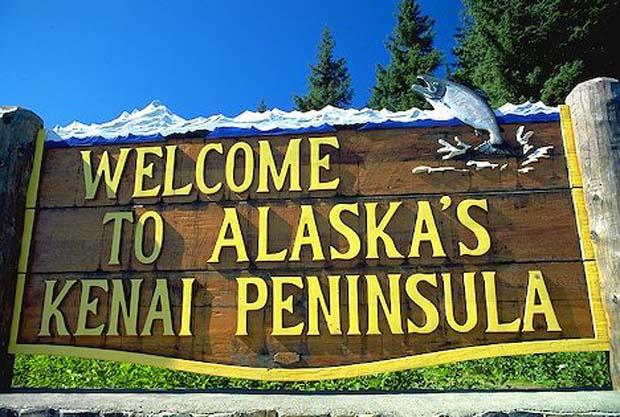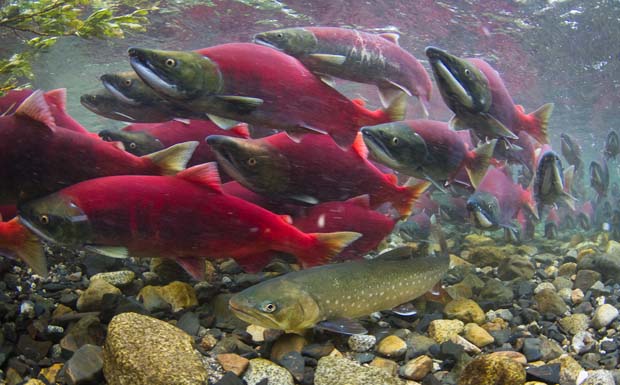Alsaska is special. Why?
[dropcap]T[/dropcap]hat’s a question that is unique to every person that has ever visited the “last frontier” state. For me, it’s all about the fishing. Yeah, there’s the epic scenery. Snow capped peaks that seem close enough to touch, but are really miles high. Bald Eagles by twos and threes seemingly around every bend in the river. Moose cross the roads like our whitetails. Brown Bear as big as furry Volkswagons keep you looking over your shoulder. Yeah, that’s all great, but for me it’s about massive fish, huge numbers of them, on a flyrod. It’s about ending the day with your hands sore, finger tips shredded, and arms aching from fighting and landing fish. It’s about fish bending a 12 weight rod hard enough to make it flex all the way through the cork grip.
I’ve been making the pilgrimage to Alaska’s Kenai Peninsula since 1999 when my parents, brother, and I spent 19 days visiting my cousins in Anchorage. I fished almost every day of the 19, and learned from my cousins the basics of what, where, and why for. The very next year I returned with a group of four friends, and we learned even more. Over the ensuing years I returned every year I could, only omitting the summer I got married (sacrifices must be made), and the years one of my best friends experienced a very serious extended illness. Make no mistake, not going was tough, and Alaska has a way of calling you back.
Usher in 2013
My buddy has recovered, my awesome wife has given me her blessing (okay, at least her permission), and plans were made. My dad Homer, my brother Parke, and my buddies Jeff Boyer and Bob Ewing, and I have all signed on for the journey. August 1 through August 8 is to be our time frame. Not because it’s the optimum time to go, it’s not bad mind you, but not optimum either. The “on” weeks book years ahead of time. Once, when we were making the trip every summer, we had standing reservations for the third week of July. When things got interrupted by the fickle hand of bad luck, we lost our spot. Now, we’ll take what we can get.
The flight is an ordeal. If you’re lucky, you make two legs of the trip. One leg of about two and a half hours, and the second around six and a half hours. I am a wide individual. Yes, I like food. The seats in coach must be designed by 10 year old girls, or androgynous men with physiques like Pringles cans. Rubbing shoulders for 6 hours with your row-mates is not nearly as much fun as it sounds. With everything considered, I’d fly twice as far to get there: it’s that good. This past August I flew separately from my 4 fellow adventurers. I had a voucher for one airline, and the tickets were cheaper on another. I will try very hard not to do that again. A significant part of the fun is sharing the misery of the flight with those you care about. Some of our funniest stories are from the flights we’ve made. One of the best things about the flight is the bird’s eye view of the Brooke’s Range covered in glaciers and snow. How anything lives there is beyond my ken.
Arriving in Anchorage
The plane comes in low over Cook’s Inlet, and you get your first view of the varied landscape of Alaska’s Kenai Peninsula. Here we fly over flat, mud filled marshes surrounded by the signature spruce trees that dominate much of Alaska’s arboreal plant life. We rent cars at the airport and drive south on the Seward Highway towards the sea port of Seward. The drive is predominantly through the Chugach National Park. On the way, rocky cliffs jut straight up right beside the road. With cliffs to the left, and Cook’s Inlet immediately on the right, it’s hard to decide where to look first. We always keep a close eye on the cliffs, as Dall Sheep are frequently seen standing on nothing, defying gravity along the cliffs next to the road. White Beluga whales are often seen swimming parallel to the highway chasing schools of salmon, especially on the even numbered years when Pink salmon swarm the inlet. We pass over Bird Creek. It’s great when the Silver salmon are running, but it’s too early the first week of August. On we travel stopping at Girdwood. Girdwood is basically a rest stop with a small strip mall. We really don’t need anything, but there is a nice bakery in the strip mall, and the gas station has corn dogs. Refueled, we drive on, and in a few miles, a large wooden sign signals the true beginning of the Kenai Peninsula. On and on, up and up, the road from here on is literally all up hill. We drive thousands of feet up though the passes. Eventually we get to the fork in the road where the Sterling Highway turns right off of the Seward Highway. We know now we are getting close.
 Lake Kenai comes into view on the left side of the road
Lake Kenai comes into view on the left side of the road
Written descriptions of this glowing turquoise gem surrounded by the deep, almost black, green spruces that line its shores cannot do it justice. Standing on its shores, gazing across it at the ice topped mountains that seem to be protecting this almost sentient place of peace, a simple man can’t help but have his spirits lifted. Barring none, it is the most beautiful place on Earth I have ever seen, and I have been fortunate enough to see some wonderful things. The small village of Cooper’s Landing is immediately after the lake. Situated on the shore of the Kenai River flowing out of the lake, it is almost completely made of lodges and guides. We keep driving. After a bit, we come to what is known as the Sanctuary. Here the fabled Russian River meets the Mighty Kenai River. Sockeye salmon run up the Kenai from Cook’s Inlet and use this confluence as a staging area. Some run up the Russian River to fulfill their lives’ purpose, others continue up the Kenai River into Lake Kenai, there to spawn and return their essence to the ecosystem. This staging area brings, and this is no exaggeration, thousands of fishermen. The conditions can get so fierce that the park rangers at the Russian River Ferry will loan fishermen safety glasses, and the Fish and Game folks actually publish “rules for combat fishing.” We’ve tried it. Now we avoid it. Salmon hooks are large, the sinkers required to get your fly down are abnormally heavy. Removing a number two hook from your cheek does not seem like a giggle, and ask my brother, catching a one-ounce sinker on the end of a snapped line in your throat is no picnic. We look for less populated fishing venues.
Past the Sanctuary
We drive on to the village of Sterling. It’s defined as a village or town, but in reality it’s a bunch of lodges, shops, and other dwellings spread out very sparsely over a few miles. Here we have booked a cabin from Ed. He owns and operates with his daughter a “lodge” called, Alaska Cozy Cabins. The lodge is really not a lodge as most people think of it, but rather it is several small cabins that Ed hand built many years ago. The rates are very reasonable, and they maintain them fastidiously. They all have private baths, small kitchenettes, and sleep from two to eight people, depending on how chummy you want to be with the other members of your party. As fast as you can say, “Where do we want to fish first?” we are in our waders, and in the vehicle headed for the closest spot. It happens to be a city park called Swiftwater. It is run by the city of Soldotna, which is about 15 minutes down the Sterling Highway from our cabin.
There are a few people fishing, but plenty of room to get in the water for the five of us and not be anywhere close enough to our nearest neighbors to be in danger of flying hardware. Our intended targets are Sockeye salmon. They are fighters beyond comparison, and unmatched table fare. We use very stout tackle, tackle usually reserved for saltwater species that weigh in over 100 pounds like Tarpon. Twenty to 30 pound fluorocarbon leader, 12 weight rods, and reels that have truck stopping drags are our preferred set-ups. Is this really needed? These fish will straighten number two salmon hooks, and snap twenty pound test leader. Yes, you can catch them on lighter tackle, and many people do. I prefer my battles to last less than 20 minutes per fish, and I really don’t relish a one hundred yard dash down a rocky shoreline. The Reds as they are known, hug the shore line. Twenty feet of line out the end of a rod is more than enough. The current is very deep and fast, and it requires a sinker of up to an ounce of lead to get the fly down to the fish. Many people will tell you that Sockeye salmon don’t bite, and that you have to “floss” them as they swim up current with their mouth open. I will not argue that they don’t eat, but strike they will. I have seen Reds in shallow, clear water charge a fly the way my Labrador comes after a cookie. I think they are like King salmon. When a King enters fresh water from the salt, it stops feeding, but they are temperamental killers, and will attempt to kill anything that “annoys” them. I think the Reds do the same. I also have it on very good authority that they can and have been caught on top water fly patterns. I will bet a large sum that you can’t “floss” a salmon with a floating fly!
In only a few casts the first “Fish on!” sounds. It’s a chrome bright sockeye of about nine pounds. On the stringer it goes, and back to the “chuck-and-duck”, or “slapping the water”, as many call it. The fishing is slow, but what we catch is beautiful, and dime-bright. Upon returning to the cabin at about 11 p.m., and yes, it’s still light out, we discuss the fishing. We decide that the main body of fish are past Swiftwater and on up river. The next morning we head for the Sanctuary. We cross the Kenai on the Russian River Ferry, and notice that to the left, upstream from the ferry, the river is choked with anglers in full combat mode. Without a thought we turn right, and head down river into bear country and much less crowded venues. As we walk, we are about 20 to 30 feet above the river, and we can see a constant swarm of Reds swimming upstream. The excitement and urge to wet our lines gets almost overwhelming, but we walk on for maybe a half mile. Here the river makes a wide bend, and there are numerous holding areas for salmon to pause in. Here we make our stand.
Editor’s note: The first in a two-part series from Homer Kreinbrook Jr., of Berlin. He is a Physics Teacher in the Somerset Area School District and President of the Somerset Fly Fishers.











I’ll answer the headline question, since I wrote the article. I’ve fished all up and down the eastern seaboard, Idaho, Montana, and Louisiana, but NOTHING matches Alaska. Its the perfect combination of accessibility, affordability, and lots of huge fish.